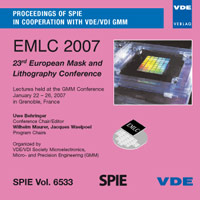A Cost Model Comparing Image Qualification Using Test Wafer and Direct Mask Inspection
Konferenz: EMLC 2007 - 23rd European Mask and Lithography Conference
22.01.2007 - 26.01.2007 in Grenoble, France
Tagungsband: EMLC 2007
Seiten: 6Sprache: EnglischTyp: PDF
Persönliche VDE-Mitglieder erhalten auf diesen Artikel 10% Rabatt
Autoren:
Bhattacharyya, Kaustuve; Hazari, Viral; Sutherland, Doug (KLA-Tencor Corporation, USA)
Higashiki, Tatsuhiko (Toshiba Corporation, Japan)
Inhalt:
Litho-cluster cycle time will drive the economics for fabs even harder at nodes 65nm and below. Any methods or techniques that can reduce this litho-cluster cycle time need to be looked at seriously. Besides running production, a small part of the litho-cluster time is also used to expose test wafers for mask qualification on a periodic interval. Incoming mask inspections as well as periodic mask inspections (re-qualification) in advanced wafer fabs are a necessity to prevent yield loss from progressive mask defect problems (such as crystal growth or haze), traditional reticle contamination, ESD and migrating defects (from non-critical to critical location on mask). This mask inspection can be achieved via two methods. The first method is indirect, commonly known as image qualification, where a mask is being exposed followed by the inspection of the printed wafer to detect if there is any repeater on the wafer or not. The other method of mask inspection is direct mask inspection (such as STARlight(TM)). A lot has been written on the technical advantages of direct mask inspection over image qualification. This technical report discusses a cost model developed to compare the financial impact of image qualification to direct mask inspection like STARlight. In this model all the inspection and process tool costs are included as well as turn-around-time (TAT) at the litho-cluster for image qualification and TAT for STARlight. Then, the inspection cost and the opportunity cost (for using litho-cluster to expose test wafers other than production wafers) are combined and the net effect is compared. The goal is to find the most cost effective way to do mask qualification in advanced wafer fabs.


